The wait is over: on Wednesday 6 March Michelangelo Pistoletto‘s new Venus received a warm welcome, vibrant and colourful like the heap of rags she holds up. There was hype, excitement and trepidation for the presentation of Cittadellarte’s founder’s iconic work. The inauguration of the sculpture had the eyes of the world on it, and not only virtually: journalists, students, artists and citizens from all professions and generations turned up in person to greet the work, reborn from its own ashes after a fire destroyed the first installation. As reported in a previous article, after last summer’s fire, the artist wanted to rebuild the installation and the mayor expressed his willingness to support the operation: the result was the donation of the work by the artist¹, thus confirming his deep bond with the city; the municipality will take care of the expenses for round-the-clock surveillance instead. This way, Pistoletto reiterated his desire to promote art as an educational tool, a driving force for social transformation, especially in fragile contexts.
The unveiling was the topic of a press conference held in Sala Giunta in Palazzo San Giacomo with the participation of the curator of the project “Napoli Contemporanea” Vincenzo Trione, the vice-president of the association Altra Napoli EF Antonio Roberto Lucidi, the mayor of Naples Gaetano Manfredi and Michelangelo Pistoletto, as well as the coordinator of the Rebirth/Third Paradise ambassadors Francesco Saverio Teruzzi and Father Antonio Loffredo. It was announced that the work will be on display in Piazza Municipio for three months, at the end of which it will be moved to its definitive location. Technical tests are currently underway in the Church of San Pietro ad Aram, a place of great historical value on the outskirts of Naples that could benefit from this opening to the contemporary.
The press conference.
The new Venus and the relationship with the first version
The press conference began with Trione‘s speech, who illustrated the artistic link between the two versions of the work that have been created: “The first one presented last June, the fire in July and the new version are three moments of a single gesture, three parts of a unified project.” he began, “On the day of the fire, we could follow one of two paths: to succumb and take note of an event that had within it a tragic and at the same time sublime dimension, or to react. The mayor’s immediate reaction was to roll up his sleeves, so we have remade a work that is only apparently the same as the one from last June: the installation is made of the same materials and composition, yet it is a Venus that has not healed her wounds: the work’s soul and structure have survived the fire of last July and we have all treasured the wounds in order to start again”. The work therefore conveys a sense of rebirth: “The result,” he explained, “is the child of a project that is not Pistoletto’s alone, but belongs to the whole community: it is a collective, poly-authorial work, in which the City Council and the friends of Cittadellarte and AltraNapoli have been an active part. The new Venus of the Rags,” he specified, “is no longer just a work of contemporary art: this movement is often condemned to indifference, whereas this installation has been one of the very few works that have become part of the public and international debate for years”. The curator of the project “Napoli Contemporanea” went on to comment on the controversy surrounding the work’s uniqueness, pointing out that since his first Venus of the Rags in 1967, Pistoletto has created several versions that are all unique works of art. “It is a deeply iconic work,” he added, “that has earned a place in art history books and does not leave us indifferent. One of its strengths is precisely its ability to engage even those who are not particularly interested in contemporary art to reflect on it”. Trione went on to illustrate the role that the work can play for the city of Naples: “It has both historical and artistic as well as civil and political significance, because it is based on the theme of contrast, of antitheses: us and them, perfection and imperfection, classical sculpting and consumer civilisation, metaphysical beauty and the ungrammaticality of contemporaneity. What is Naples if not a city that lends itself to a double take?”
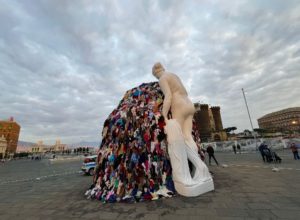
The Venus of the Rags. Photo by Alessandro Lacirasella.
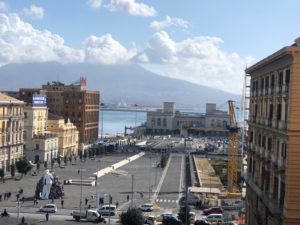
The Venus of the Rags in Piazza Municipio.
Solidarity
After the fire, Altra Napoli had launched the crowdfunding campaign Ricostruiamola! (Let’s rebuild it!), which was welcomed by the municipality and received support from numerous citizens. The funds raised from the crowdfunding campaign were allocated to two local organizations with social objectives: the association “La Scintilla”, which works for the protection, accompaniment, socialisation and serene autonomy of people with intellectual disabilities, and the social cooperative “Lazzarelle”, committed to the rehabilitation of women affected by a detention regime who want to be active protagonists of their own change through their reintegration in qualified work projects. This story was told during the press conference by the vice-president of the association Altra Napoli: “When the fire broke out, we were immediately called to rebuild the work, which made us understand its great social value,” this was the introduction by Antonio Roberto Lucidi, “and how the aching city had its nerve endings in these rags. When the artist asked us to suspend the crowdfunding and identify organizations in support of the socially fragile to which to donate the resources raised, we opted for the social cooperative “Lazzarelle”, which for years has been pursuing the redemption of women afflicted by detention regimes in Pozzuoli, and for the association “La Scintilla”, which helps people with motor and cognitive disabilities”. Lucidi then mentioned how attention towards frailty can be one of the keys to Naples’ rebirth: “I believe that care towards people with disabilities of any kind can be the spring enabling the city to grow. For me, the Venus communicates a profound message of solidarity and personal growth”.
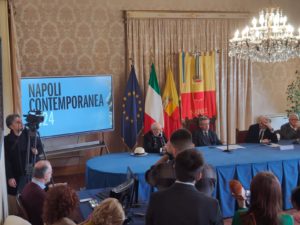
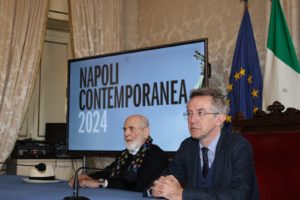
The press conference.
Venerability
Michelangelo Pistoletto began by illustrating the meanings of the Third Paradise, to then talk specifically about the Venus, which, “like the trinamic symbol,” he explained, “has a duality, because it represents veneration, but at the same time she is holding up rags, which represent disintegration. Venus is the profound beauty of the human spirit that spans all times and, not by chance, the word Venus means venerability”. The artist then drew a parallel between the city of Naples and his work: “Naples also has an extraordinary venerability: it is illuminated by art, in contrast with its most problematic and degenerative side. My work,” he emphasised, “must drive everyone to work on regeneration: we must take the heap of rags back into our hands and turn it into a work of art”. The founder of Cittadellarte concluded by sending a thought to Simone Isaia, who was responsible for the burning of the first Venus: “Chance has it that the place where we hope he can start a path of recovery is called “La Scintilla” (i.e. the spark), a significant name, considering he is the one who generated an actual spark. Even though he committed that ‘crime’, I would like to embrace him, but how do we avoid monstrosity if we do not know how to embrace it with the venerability of our most enlightened thinking?”
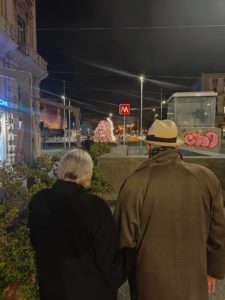
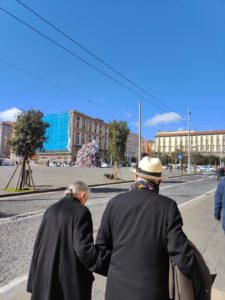
Maria and Michelangelo Pistoletto. Photo by Margherita Cugini.
From the Venus of the Rags to the Third Paradise
Francesco Saverio Teruzzi, coordinator of the Rebirth/Third Paradise ambassadors, also spoke on the occasion. “We have been going around Naples with a mirror panel since Wednesday, asking people we’d meet to put their names on it. It is a way of communicating that you want to participate in the rebirth process, because the Third Paradise is a symbol of proposal and harmony, which leads to regeneration”. Teruzzi was then asked about the organisation of collateral initiatives to the work: “The Rebirth ambassadors and I,” he announced, “are always available to listen and make new ideas flourish. I anticipate that we would like to organise events with schools and associations. On the closing day of the school year, for example, we would like to propose a flash mob of the Third Paradise around the Venus of the Rags, making use of the music that Altra Napoli will provide”.
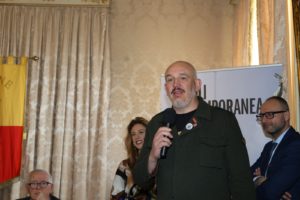
Francesco Saverio Teruzzi.
The future
The mayor retraced the process that led to the birth of the new Venus: “It has been a complex process,” said Gaetano Manfredi, “we must admit that the fire represented a great moment of reflection and enrichment for us. The work was born with the idea of mirroring the contrasts of our city: its extraordinary beauty and its great suffering, the pursuit of beauty but also the consumerism destroying it. The event that occurred, i.e. the fire, reinforced the idea of contrast and contradiction: it was a gesture that brought out social suffering”. The first citizen then turned his gaze to the future: “We understood that we had to internalise this episode and carry on on our path, with an inclusive restart. The theme of conflict and contrast should not be forgotten, as represented by the Venus, but also by society on a daily basis. This is why we decided to regenerate the work, also thanks to Pistoletto’s act of generosity. The evocative power of beauty,” he said, “is an energy that helps us change”. Finally, Father Antonio Loffredo spoke, announcing, as mentioned earlier, the probable future home of the Venus, namely the Church of San Pietro ad Aram. “We will keep the work in a sacred place: a church. Let this be a warning: if we manage to accommodate the fragile within our prayers and structures,” he concluded, “we will have created a masterpiece”.

